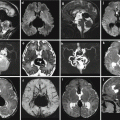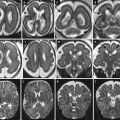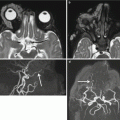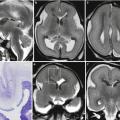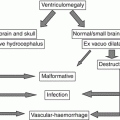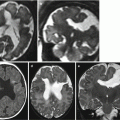Fig. 1.1
Fetal MR autopsy. Normal brain at 22 gestational weeks (GW) (a) and 21 GW (b) on T2-weighted images. Voxel size 100 nl.
1.1 Fetal MR Autopsy Technique
In order to prevent postmortem tissue autolysis, fetal MR autopsy studies were carried out within 24 h from death, without any fixation, in an intact fetus conserved in a refrigerator at 4–5°C prior to MR examination. The fetuses withspontaneous death in utero were not considered due to their long permanenceat body temperature that accelerates the autolysis.
To obtain comparable images with the in vivo study, it is important to preserve the natural tissue contrast on T1 and T2-weighted images. The standard fixation with formalin causes a marked tissue dehydration and a modification of T1 and T2 contrast [7, 8]. On the contrary, an MR study performed within approximately 24–28 h from death without any fixation and with the fetal brain in situ, allows to maintain the normal contrast differences betweentissues. It should however be noted that even though cooling may preserve fetal brain from autolysis, it nevertheless decreases the T1 and T2 contrast between tissues [9], and of course postmortem imaging cannot be considered the same as clinical imaging in a living being. The absence of blood pressure can change the shape of vessels and of the brain, resulting for example in a kinking of the brainstem. The vaginal delivery may cause deformation of skull and brain as well. Blood elements sedimentand intravascular clots may finally occur [10].
To obtain a reasonable compromise between acquisition time in a clinical setting and spatial resolution, the total acquisition time of a fetal MR autopsy is approximately 80 min by using a3.0 T magnet. The T2-weighted images shown in this chapter are obtained applying a turbo spin-echo sequence (TR 6500 ms; TE 120 ms; FA 90°; NEX 4,acquisition time 20 min.); the voxel size was 0.3 × 0.3 × 1.2 mm, equal to a true spatial resolution of 0.10 mm3 (100 nl).
1.2 Fetal Anatomy on MR Autopsy
On the T2-weighted images of the fetal MR autopsy with spatial resolution of 100 nl, not only thethree layers usually recognizable on in vivo fetal MR are visible, but also layer number 1, the marginal layer (Fig. 1.2), and, at least between 19 and 28 GW, a thin hypointense layer in the most external part of the subplate (Fig. 1.3). According to Kostovic et al., this thin layer could represent thalamocortical axons in the superficial layer of subplate that are waiting to enter the cortical plate [11], but at present, no correlation between these images and corresponding pathological specimens is available.
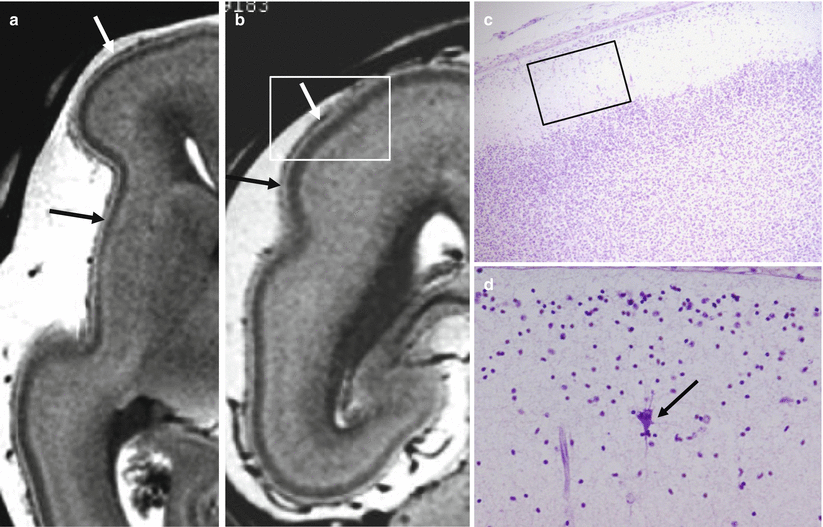
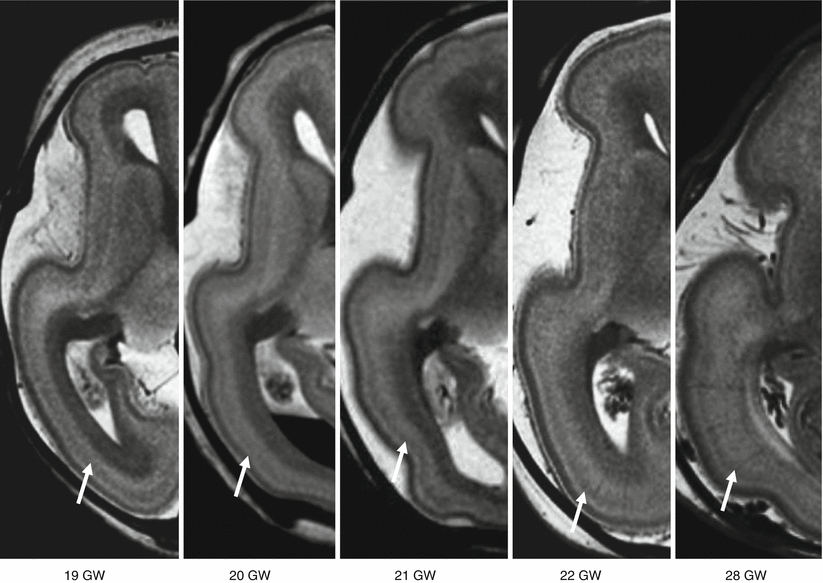

Fig. 1.2
Marginal zone on fetal MR autopsy (22GW). Layer I or marginal zone is detectable on fetal MR autopsy with a voxel size of 100 nl (arrows a , b). Correspondent histologic section stained with hematoxylin–eosin (c) and closeup view on marginal zone shows a large Cajal–Retzius cell (black arrow) (d) (courtesy C. Frassoni, Neurological Institute C. Besta, Milan)

Fig. 1.3
A diffuse T2 hypointense layer on the more external part of subplate is recognizable on fetal MR autopsy between 19 and 28 GW (arrows). According to Kostovic et al., it could represent thalamocortical axons in the superficial layer of subplate that are waiting to enter the cortical plate
If we compare the single-shot T2-weighted images of the in vivo fetal MR (Fig. 1.4) with the turbo spin-echo T2-weighted images of the fetal MR autopsy (Fig. 1.5), we can highlight some changes in tissue contrast in the period between 19 and 22 GW that are barely visible on in vivo studies. Between 19 and 20 GW, the internal capsule and in particular the posterior limb of the internal capsule (PLIC) is clearly more hypointense than surrounding lentiform nuclei and thalami (Figs. 1.5, 1.6, 1.7, 1.8, 1.9, 1.10, 1.11, 1.12, 1.13, and 1.14); this is of course not due to the presence of myelin, it develops later in the last phase of gestation, but probably to the differences in contrast between the relatively compacted unmyelinated fibers and the relatively poor synapse density of the basal ganglia and thalami. Starting from 21 to 22 GW, the anterolateral aspect of the thalami before and the mesial part of the lentiform nuclei shortly after, begin to decrease their signal intensity on T2-weighted images and consequently PLIC becomes scarcely visible (Figs. 1.15, 1.16, 1.17, 1.18, 1.19, 1.20, 1.21, 1.22, 1.23, 1.24, 1.25, 1.26, 1.27, 1.28, and 1.29).

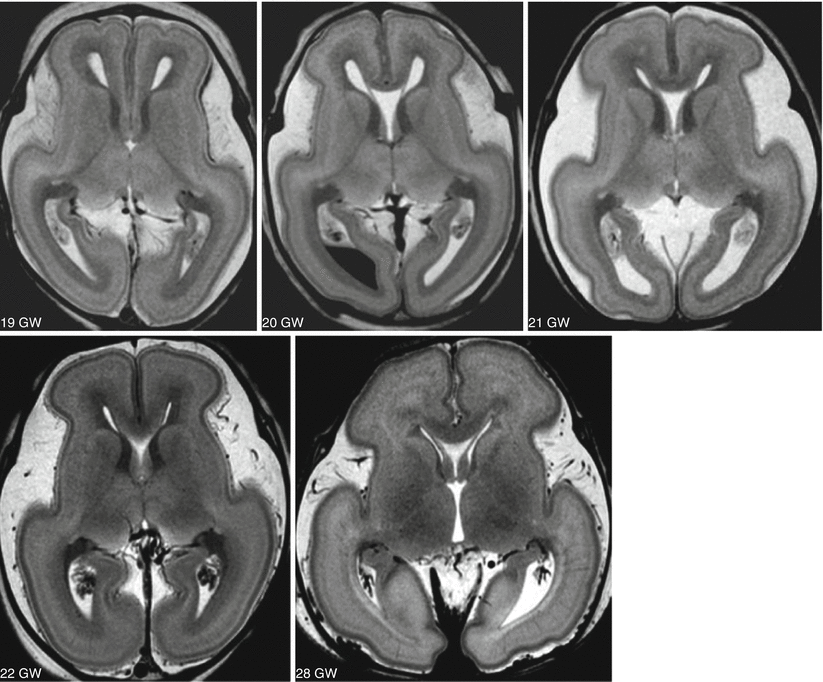
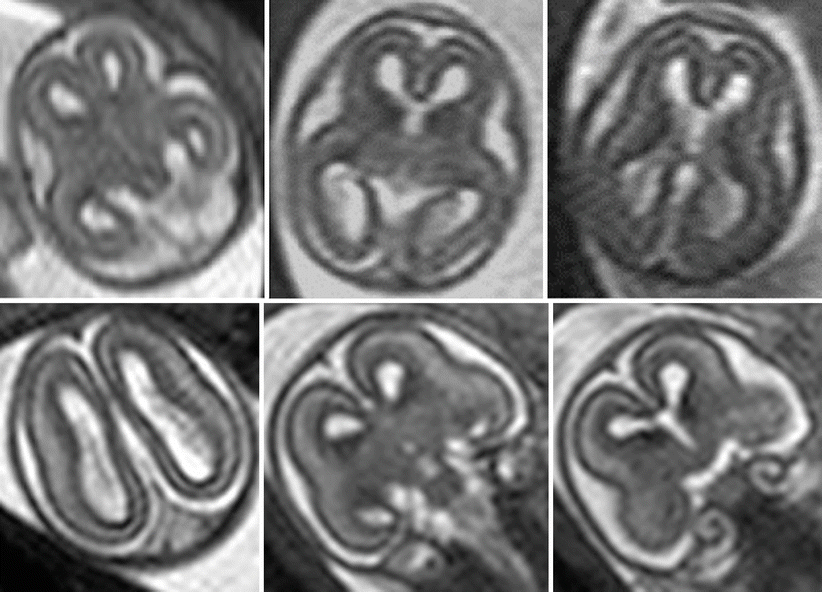
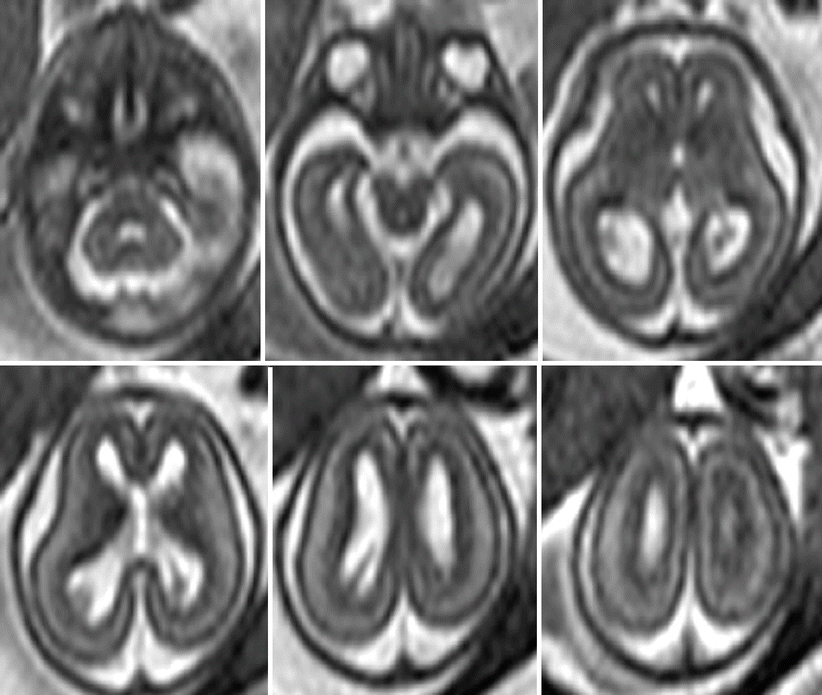
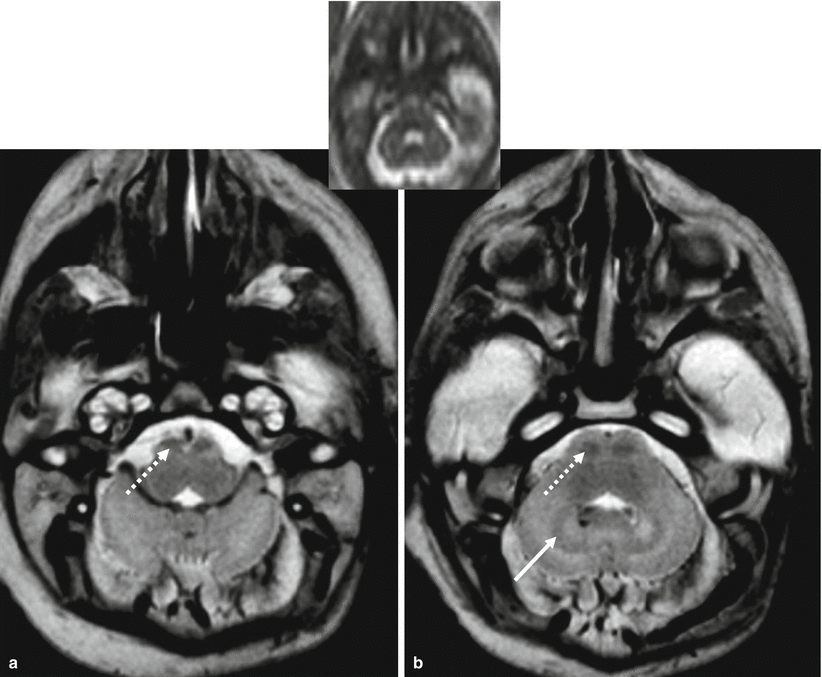
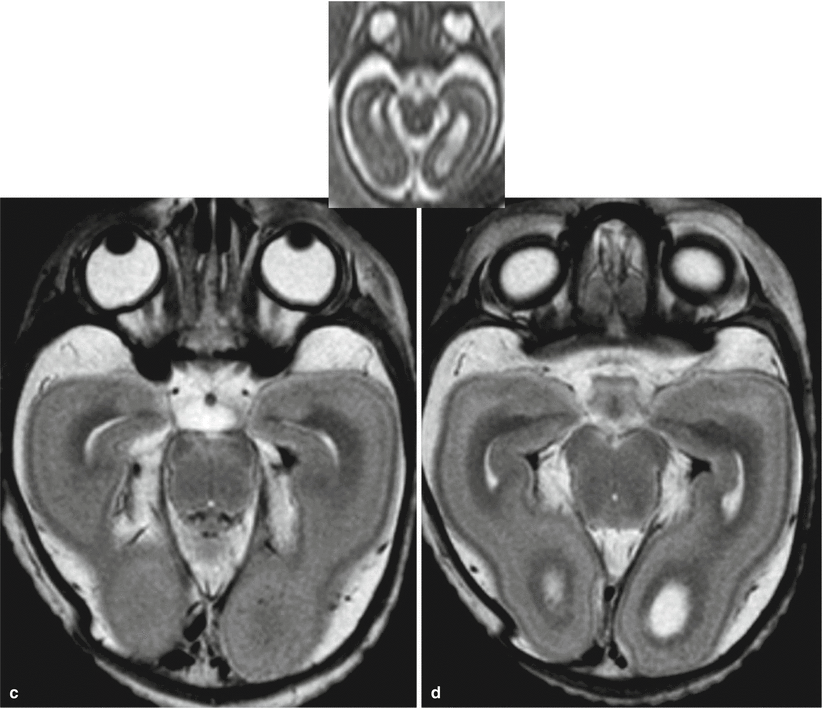



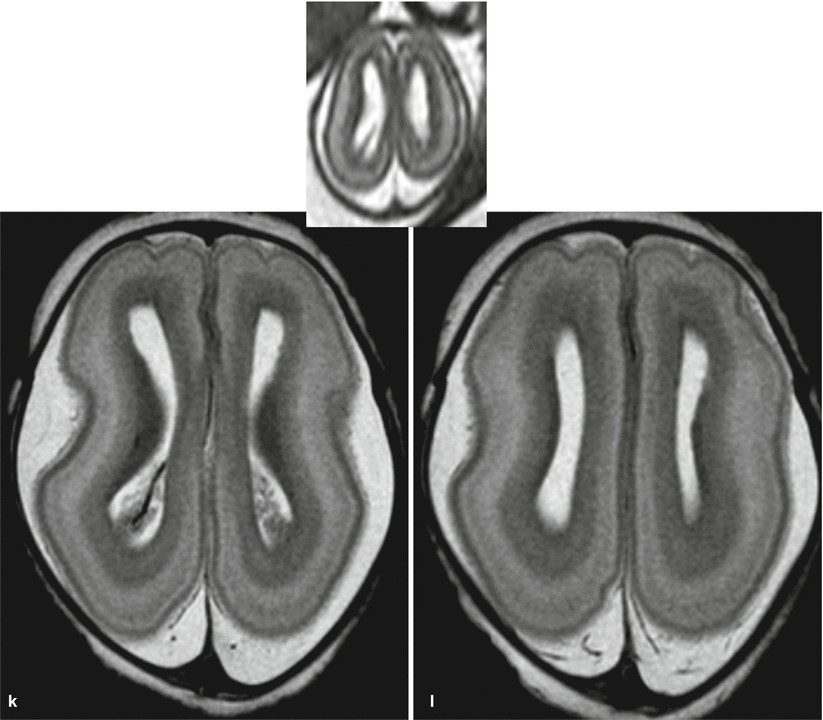
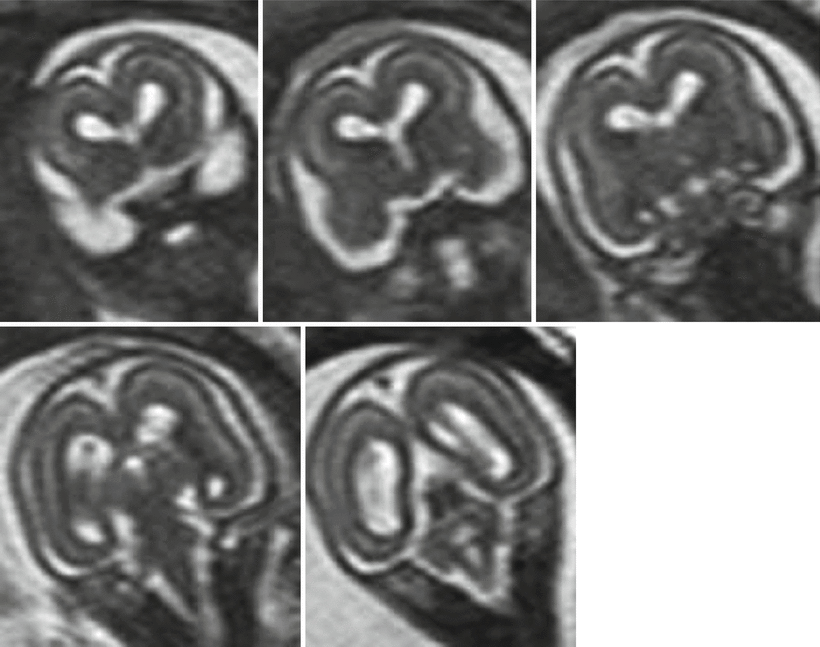
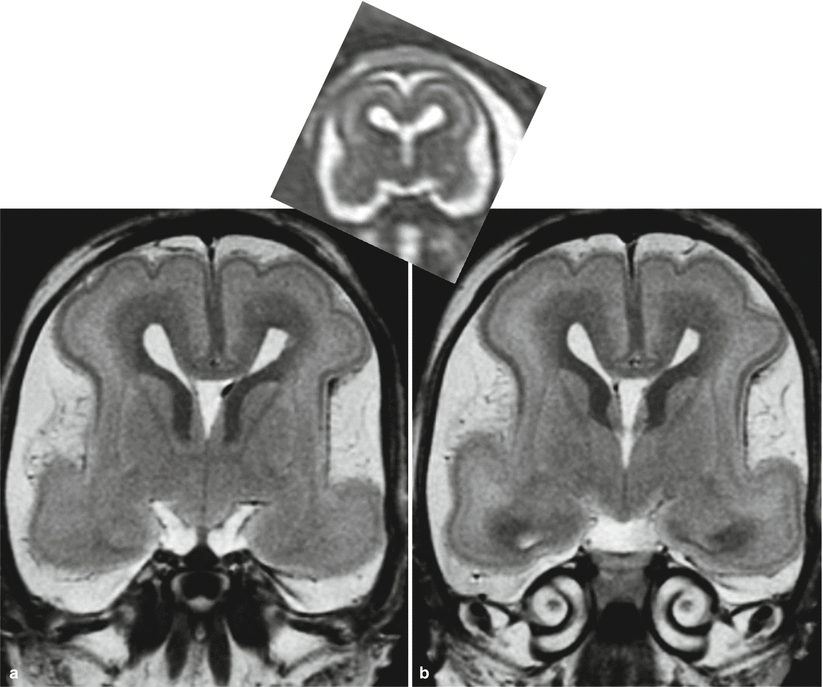
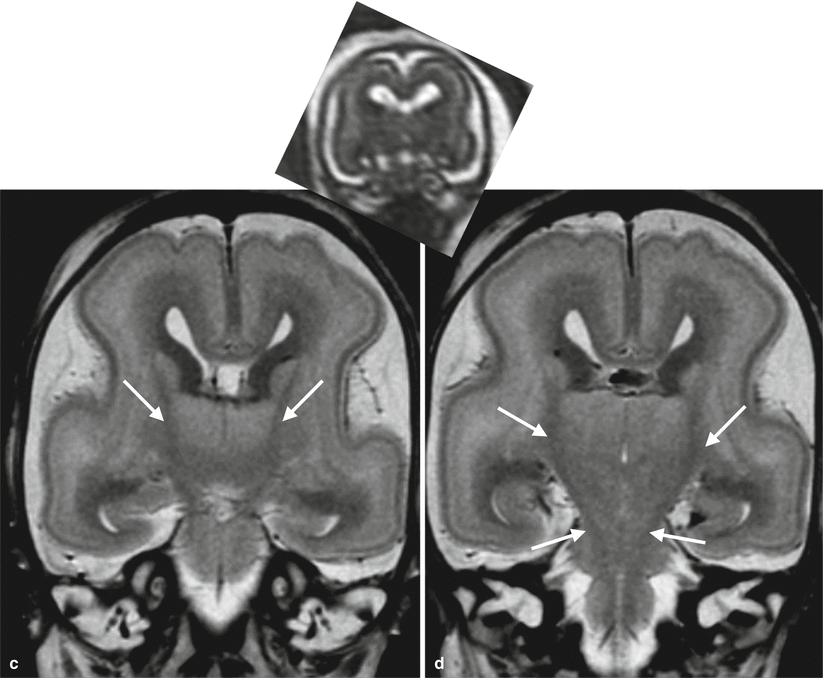

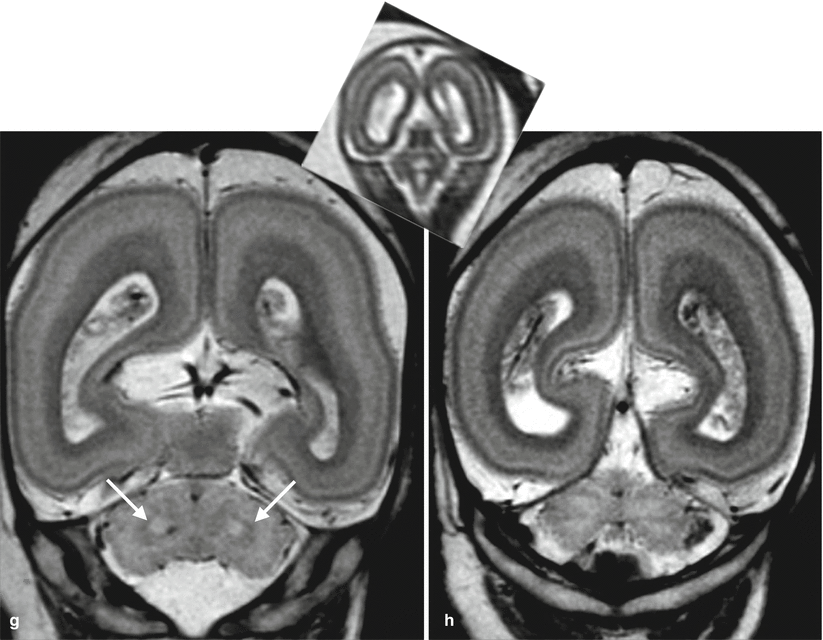
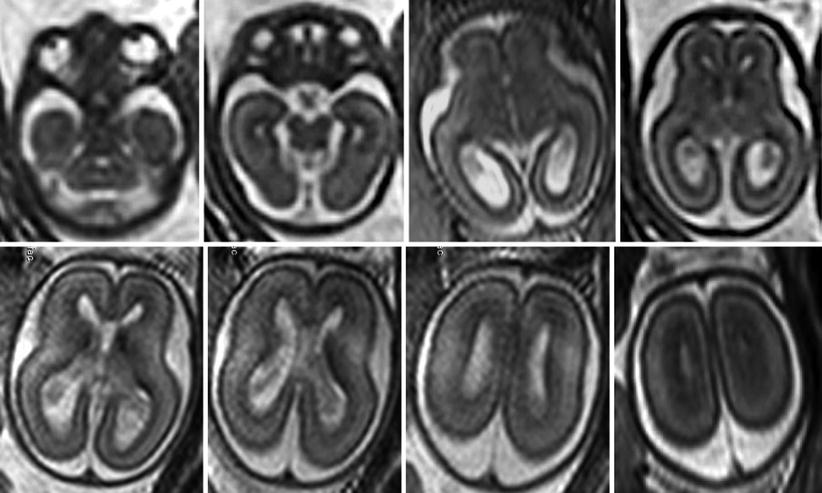




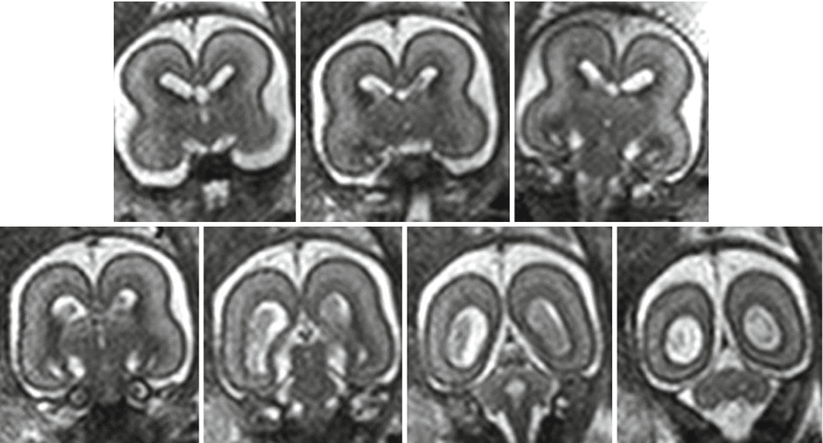
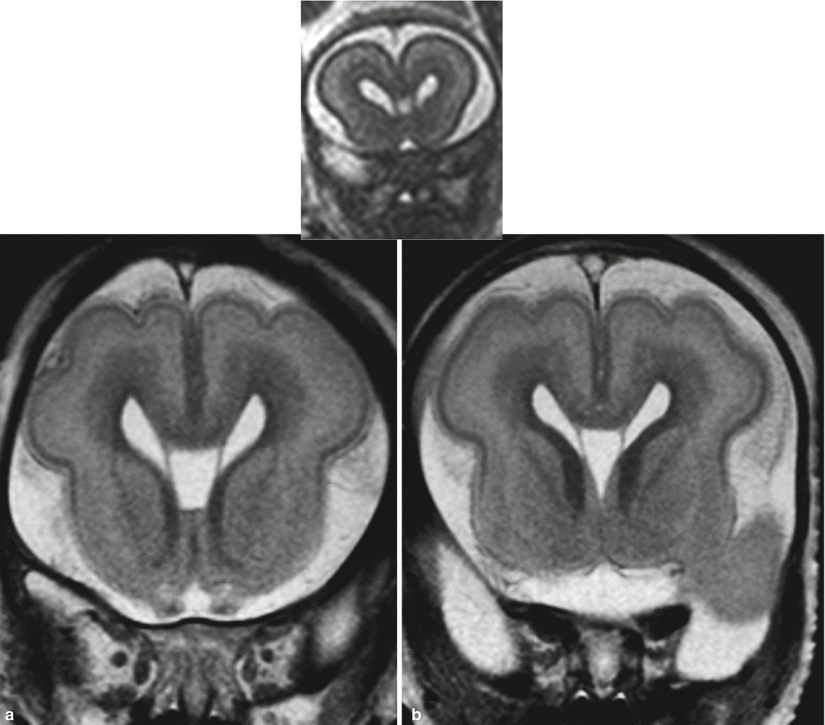
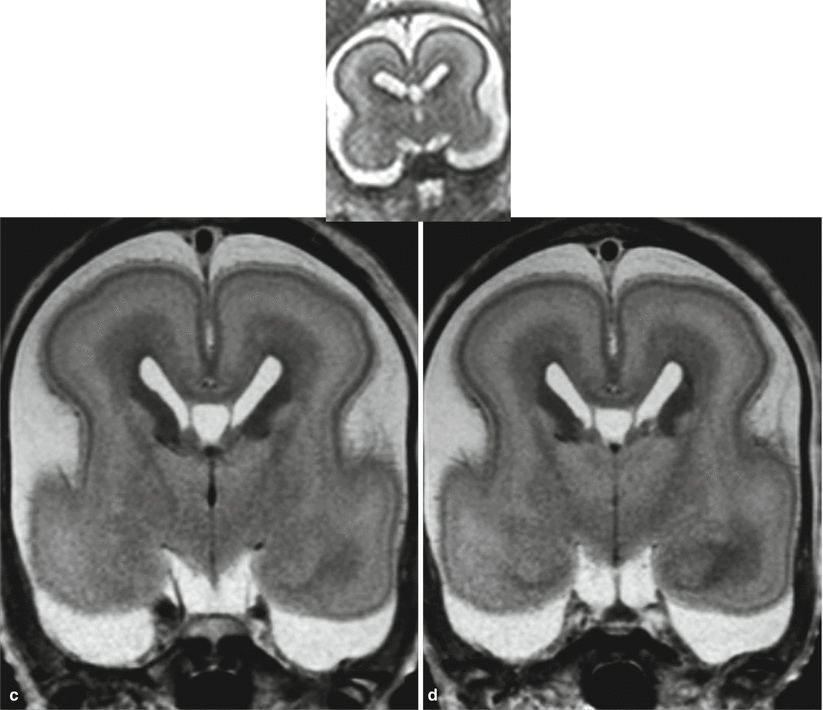
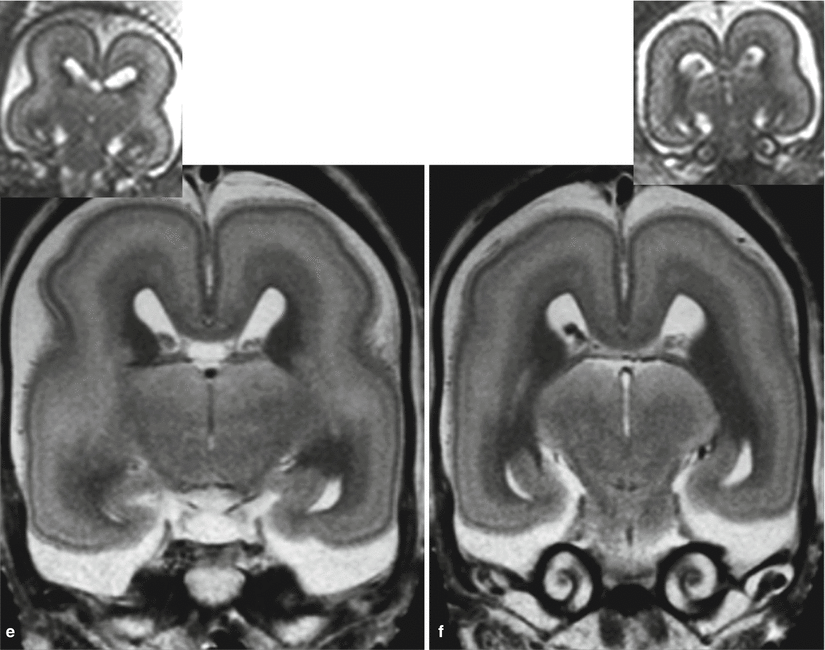
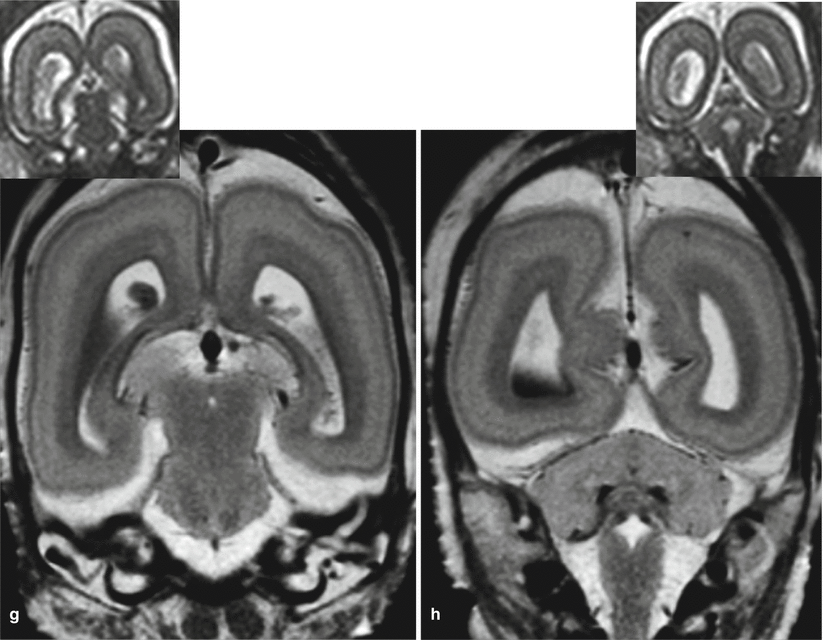
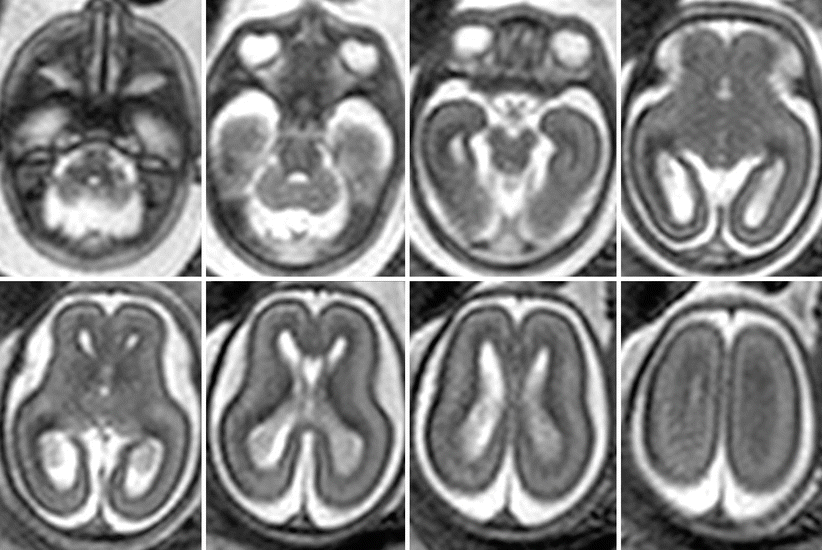
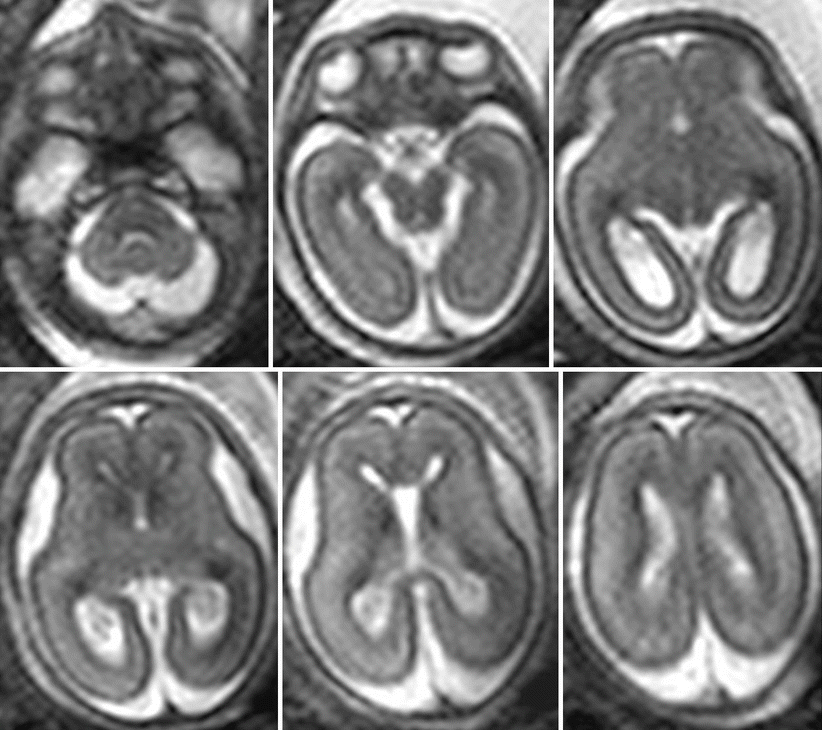

Fig. 1.4
Normal fetal brain development according to fetal MR. Twelve selected cases from 18.2 to 32.2 GW, axial T2-weighted images passing approximately through the thalamus. For the acquisition technique, see the text

Fig. 1.5
Fetal MR autopsy. Normal cases at 19, 20, 21, 22, and 28 GW, representative axial T2-weighted images passing through the thalamus. Voxel size 100 nl. For the acquisition technique, see the text; all the cases are studied within 24 hours from termination of pregnancy (TOP)

Fig. 1.6
Fetal MR, normal brain at 18.2 GW. Fetal MR is usually not performed before 19 GW. The fetal brain size is too small and the fetal movement is more pronounced. In this case, the parenchymal thickness is still relatively thin in comparison to the ventricular size (top row). T2 signal contrast differences between cortical plate, subplate, and intermediate zone are however already appreciable (bottom row)

Fig. 1.7
Fetal MR, normal brain at 19.6 GW, axial sections. At this age, the main brain mantle layers, including germinal matrix, are usually well documented. Brain opercularization is going to become evident even though the surface of the brain is still substantially smooth






Fig. 1.8
Fetal MR autopsy, normal brain at 19 GW, axial sections with correspondent fetal MR in vivo axial sections. Even without an appreciable myelination, corticospinal tracts are recognizable as relatively T2 hypointense bilateral symmetric areas in the most antero-mesial part of the medulla oblongata (dotted arrow a) and as a small oval areas in the anterior pons (dotted arrow b). Similarly, the posterior limb of the internal capsule is already present, and even without myelin, the fibers appear as relatively hypointense structure with respect to the basal ganglia and thalamus (arrows g–h). The posterior part of the thalami, mainly represented by the pulvinar, is relatively hyperintense on T2-weighted images (asterisk g–h). Cerebellar hemispheres are still small, but dentate nuclei are already visible (b arrow). Eye globes show the typical immature aspect with an irregular oval morphology (c). Germinal matrix is clearly visible as thethick most hypointense layer along the median portion of the lateral ventricles, adiacent to the forming basal ganglia (g–k). Temporal lobes opercularization is going to be visible (d–h). The three major layers, cortical plate, subplate, and intermediate zone, are easily visible; marginal zone or layer I is also visible as well as the hypointense layer in the outer part of the subplate, likely to becompatible with thalamocortical axons. The irregular indentations of cortical plate at the level of frontal lobes are postmortem artifacts (f–l)

Fig. 1.9
Fetal MR, normal brain at 19.6 GW, coronal sections. On coronal section, the ongoing process of opercularization isbetter seen. Pituitary stalk is usually recognizable; the three major layers are clearly visible




Fig. 1.10
Fetal MR autopsy, normal brain at 19 GW, coronal sections with correspondent fetal MR in vivo coronal sections. Corticospinal tracts and the posterior limb of the internal capsule are visible in (c) and (d) (arrows), again as a slight hypointense tracts. Dentate nuclei are visible in (arrow g). Germinal matrix is clearly visible also in coronal section, both around temporal horns and laterally to the body o the lateral ventricles (a–f). Temporal lobes opercularization together with the developing hippocampus is visible in (b–f). The three major layers, cortical plate, subplate, and intermediate zone, are easily visible (a–h); marginal zone or layer I is also visible as well as the hypointense layer in the external part of the subplate, probably compatible with thalamocortical axons. Pituitary stalk together with a marked hypointense pituitary is visible in (a). The irregular indentations of cortical plate at the level of frontal lobes are postmortem artifacts (a–d)

Fig. 1.11
Fetal MR, normal brain at 20.2 GW, axial sections with FOV of 20 × 12 cm. Parenchymal thickness is progressively increasing. The three major layers are clearly visible




Fig. 1.12
Fetal MR autopsy, normal brain at 20.2 GW, axial sections with correspondent fetal MR in vivo axial sections. In comparison with Fig. 1.8, a little increase of opercularization is visible; all the other features are quite similar. The dentate nuclei are visible in (a) and the three major layers in (b) to (h).The internal capsule is still hypointense with respect to the basal ganglia (arrows, e, f). Some minor irregular indentations of cortical plate at the level of frontal lobes due to postmortem artifacts are visible also in this case (c–h)

Fig. 1.13
Fetal MR, normal brain at 20.2 GW, coronal sections with FOV of 20 × 12 cm. As for Fig. 1.9 on coronal section, the ongoing process of opercularization is better visible. Pituitary stalk is recognizable, as well as a normal cochlea; the three mayor layers are clearly visible




Fig 1.14
Fetal MR autopsy, normal brain at 20.2 GW, coronal sections with correspondent fetal MR in vivo coronal sections. In comparison with Fig 1.9, a little increase of opercularization is visible; all the other features are quite similar. On (a), olfactory bulbs areclearly visible. Some minor irregular indentations of cortical plate at the level of frontal lobes due to postmortem artifacts are visible also in this case (a, b). The germinal matrix and the three major layers are still very well evident (a–h)

Fig 1.15
Fetal MR, normal brain at 21 GW, axial sections with FOV of 20 × 12 cm. The three major layers are clearly visible. No significant changescompared to Fig. 1.11

Fig 1.16




Fetal MR, normal brain at 21,4 GW, axial sections with FOV of 20 × 12 cm. A subtle increase in parenchymal thickness compared to Fig. 1.15 seems to be visible. Generally, it does not mean necessarilythis increase represents the expected increase of brain parenchymal thickness in 4 days; of course GW datation is never so precise, but in any case, it must be take into account how the brain parenchyma can grow very rapidly around this gestational age
Stay updated, free articles. Join our Telegram channel

Full access? Get Clinical Tree



